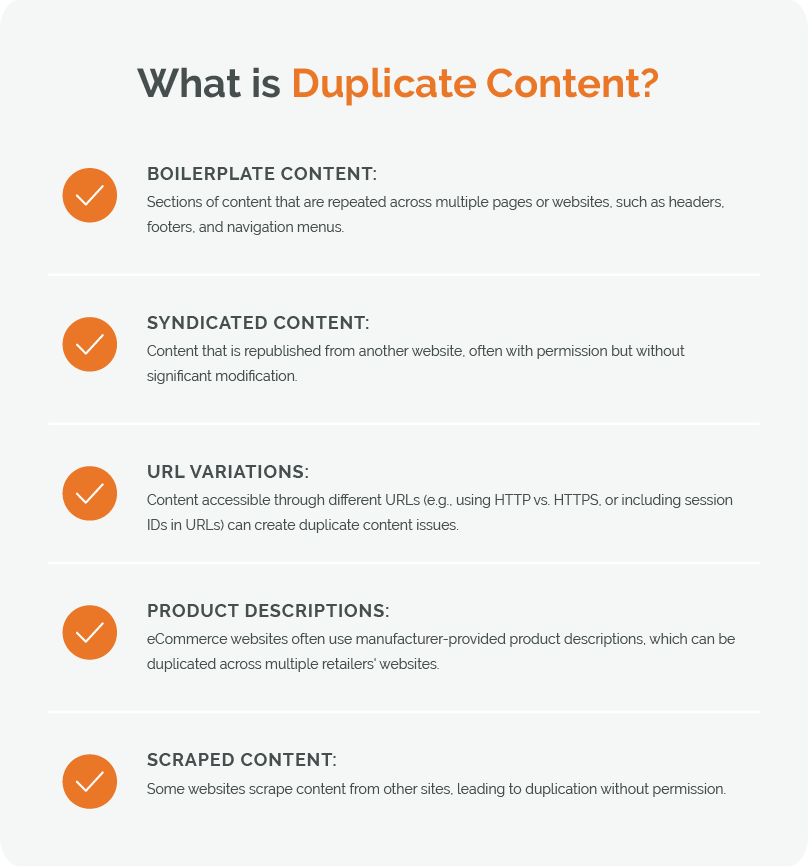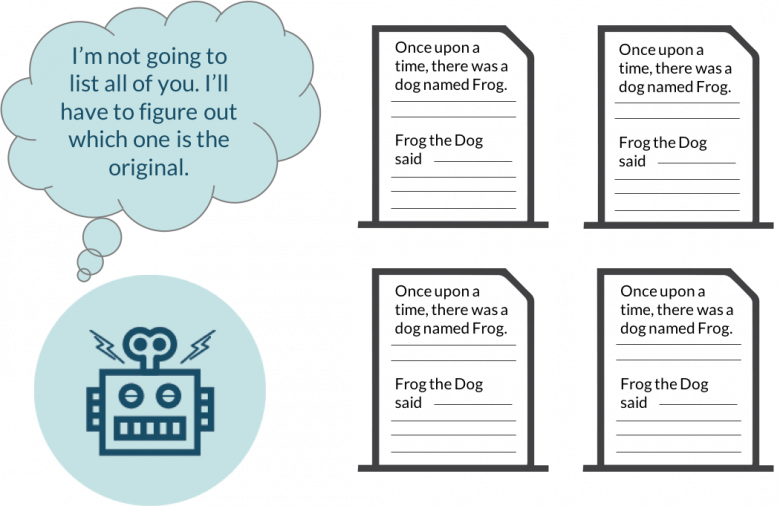Discover the truth about duplicate content, how it affects your website’s SEO, and what you can do to avoid it.

Image courtesy of via DALL-E 3
Table of Contents
- Introduction to Duplicate Content
- Types of Duplicate Content
- Internal vs External Duplicate Content
- How Duplicate Content Happens
- Effects of Duplicate Content
- How to Avoid Duplicate Content
- Fixing Existing Duplicate Content
- Tools to Help Manage Duplicate Content
- Summary
- Frequently Asked Questions (FAQs)
Introduction to Duplicate Content
Welcome, young readers! Today, we’re going to talk about something called “duplicate content” and why it’s essential to understand, especially if you have your own website. Duplicate content plays a crucial role in how websites are viewed by search engines and can impact their search engine optimization (SEO) efforts. Let’s explore what duplicate content is and why it matters for websites like yours.
What is Duplicate Content?
Simply put, duplicate content refers to blocks of content that appear in more than one place on the internet. It could be an entire webpage, a paragraph, a sentence, or even just a few words that are repeated on multiple pages. Search engines like Google want to provide users with the most relevant and unique information, so they don’t want to show the same content over and over again in search results.
Why Should We Care?
Now, you might be wondering why duplicate content matters for people who own websites. Well, when search engines detect duplicate content on a site, they might not know which version to rank higher in search results. This can lead to lower rankings for all versions of the content, meaning fewer people will see the website. Plus, users might get frustrated seeing the same information repeated, which can affect their experience on the site. So, it’s essential to understand duplicate content to ensure your website is in good standing with search engines and provides a positive experience for visitors.
Types of Duplicate Content
When it comes to duplicate content, there are various types that website owners need to be aware of. Understanding these different forms can help in managing and preventing duplicate content issues on your site. Let’s dive into the main types:
Exact Duplicates
Exact duplicates refer to content that is copied word-for-word from one source to another without any alterations. This type of duplicate content is a direct replication of the original material.
Near Duplicates
Near duplicates are similar to exact duplicates but may have minor differences in wording, structure, or formatting. These subtle variations can still be flagged as duplicate content by search engines.
Internal vs External Duplicate Content
Internal duplicate content refers to duplicate content that exists within the same website. This can happen when the same content is published on multiple pages of a website or when similar variations of content are present on different pages. Search engines like Google may have difficulty determining which page to rank in search results when faced with internal duplicate content.

Image courtesy of via Google Images
External Duplicate Content
External duplicate content, on the other hand, occurs when the same content is found on different websites across the internet. This can happen when content is syndicated or when websites copy and paste information from each other without providing proper attribution. Search engines aim to provide users with unique and relevant content, so external duplicate content can negatively impact a website’s search engine rankings.
How Duplicate Content Happens
Duplicate content often happens when someone copies text, images, or other content from one website and pastes it onto another website without permission. This can make it challenging for search engines to figure out which website should be shown in search results.
Different URL Variations
Having the same content accessible at different web addresses, or URLs, can also lead to duplicate content issues. For example, if a website can be reached through both “www.example.com” and “example.com,” search engines might see these as two separate pages with the same content.
Technical Issues
Technical problems on a website can accidentally create duplicate content. This could happen if a website’s coding creates multiple versions of the same page or if search engines index different versions of a page, thinking they are unique. These technical mishaps can confuse search engines and impact a website’s ranking.
Effects of Duplicate Content
When it comes to websites and their performance, duplicate content can have some negative effects. Let’s take a look at how duplicate content can impact search engines, SEO rankings, and user experience.

Image courtesy of via Google Images
Impact on Search Engines
Search engines like Google aim to provide users with the most relevant and diverse information possible. When they encounter duplicate content across different websites, it can be challenging for them to determine which version is the original or most valuable. This can lead to confusion and lower the trust search engines have in the duplicated content.
SEO Rankings
Having duplicate content on your website can harm your search engine optimization (SEO) efforts. Search engines may penalize sites with duplicate content by lowering their rankings in search results. This means that your website may not appear as high in search results as it could if the content was unique.
User Experience
From a user’s perspective, encountering the same content across different pages can be frustrating and confusing. If users are constantly seeing duplicated content, they may lose trust in the website and its credibility. It can also make it difficult for users to find the information they are looking for, as they are presented with redundant content.
How to Avoid Duplicate Content
One of the best ways to steer clear of duplicate content issues is to create original and unique content for your website. By crafting content that is fresh, engaging, and tailored to your audience, you can ensure that your website stands out from the crowd. Search engines love unique content, so the more original your writing is, the better your chances of ranking higher in search results.
Using Canonical Tags
Canonical tags are like little signposts for search engines, pointing them to the main version of a web page when there are multiple versions available. By incorporating canonical tags into your website, you can help search engines understand which version of a page is the most important and avoid confusion caused by duplicate content.
Setting Up 301 Redirects
When you need to replace an old web page with a new one, setting up a 301 redirect is crucial. A 301 redirect tells search engines and users that the old page has permanently moved and redirects them to the new page. By implementing 301 redirects, you can avoid duplicate content issues that may arise from outdated or duplicated pages on your website.
Fixing Existing Duplicate Content
When you discover that your website has duplicate content, it’s crucial to take action to rectify the issue and prevent any negative consequences. Here are some steps you can take to address duplicate content that already exists on your website:

Image courtesy of via Google Images
Identifying Duplicate Content
To start fixing duplicate content, you first need to identify where the problem lies. Utilize webmaster tools like Google Search Console to scan your website and pinpoint areas where duplicate content is present. These tools can provide detailed reports on duplicate meta descriptions, titles, and other content elements.
Removing or Updating Duplicates
Once you have identified the duplicate content, it’s time to remove or update it. Depending on the situation, you may need to delete the duplicated pages entirely, rewrite the content to make it unique, or consolidate similar pages into one comprehensive piece. By doing so, you can ensure that your website offers only original and valuable content to users.
Monitoring Your Website
After addressing the existing duplicate content, it’s vital to monitor your website regularly to prevent new instances from cropping up. Keep an eye on your website’s performance and use webmaster tools to check for any signs of duplicate content. By staying vigilant and proactive, you can maintain a clean and high-quality website that is favored by both users and search engines.
Tools to Help Manage Duplicate Content
When it comes to dealing with duplicate content on your website, having the right tools can make a huge difference. Here are some tools that can help you manage and fix duplicate content issues:
SEO Tools
One essential tool for managing duplicate content is using SEO tools like Google Search Console. These tools can help you identify duplicate content on your website and provide insights on how to fix it. By regularly monitoring your site with SEO tools, you can stay on top of any duplicate content issues that may arise.
Content Management Systems
Platforms like WordPress offer features that can help you manage your content and avoid duplication. Content management systems allow you to easily organize and update your website, reducing the chances of inadvertently creating duplicate content. They also provide tools for setting up canonical tags and managing redirects, which are crucial for handling duplicate content effectively.
Web Analytics Tools
Web analytics tools can be useful in identifying duplicate content and understanding how it impacts your website’s performance. By analyzing data on content engagement and user behavior, you can pinpoint areas where duplicate content may be causing issues. These tools can also help you track the effectiveness of your efforts to fix duplicate content and improve overall user experience.
Summary
In this blog post, we delved into the world of duplicate content and its impact on websites and SEO. We explored the different types of duplicate content, including exact duplicates and near duplicates, and discussed the distinction between internal and external duplicate content.

Image courtesy of via Google Images
We also explored how duplicate content can emerge through copied content, URL variations, and technical issues. Understanding the effects of duplicate content on search engines, SEO rankings, and user experience is vital for website owners.
To help prevent duplicate content, we provided tips such as creating unique content, using canonical tags, and setting up 301 redirects. Additionally, we discussed methods for identifying and fixing existing duplicate content, along with tools like SEO tools, content management systems, and web analytics tools to aid in managing duplicate content.
Recap of Key Points
To recap, it’s crucial to understand what duplicate content is, why it matters for SEO, and the various types of duplicate content. Internal duplicate content occurs within the same website, while external duplicate content spans across different websites.
We highlighted how duplicate content can arise from copied content, URL variations, and technical glitches. Its adverse effects on search engines, SEO rankings, and user experience underscore the importance of managing duplicate content.
Final Thoughts
As a website owner, ensuring your content is original, implementing best practices like canonical tags, and regularly monitoring your site for duplicate content are essential for maintaining a strong online presence. By heeding these strategies, you can safeguard your website’s performance and user experience.
Want to turn these SEO insights into real results? Seorocket is an all-in-one AI SEO solution that uses the power of AI to analyze your competition and craft high-ranking content.
Seorocket offers a suite of powerful tools, including a Keyword Researcher to find the most profitable keywords, an AI Writer to generate unique and Google-friendly content, and an Automatic Publisher to schedule and publish your content directly to your website. Plus, you’ll get real-time performance tracking so you can see exactly what’s working and make adjustments as needed.
Stop just reading about SEO – take action with Seorocket and skyrocket your search rankings today. Sign up for a free trial and see the difference Seorocket can make for your website!
Frequently Asked Questions (FAQs)
What is Duplicate Content?
Duplicate content refers to content that appears in more than one place on the internet. This means that the same text, images, or other information can be found on multiple websites or within the same website. Search engines like Google prefer unique content, so having duplicate content can impact a website’s search rankings.
How Does Duplicate Content Affect SEO?
Duplicate content can harm a website’s SEO by confusing search engines about which version of the content to index and rank. When search engines find duplicate content, they may choose to show only one version in search results, potentially leaving out the original or most relevant page. This can lead to lower visibility and rankings for the affected website.
What Can I Do to Fix Duplicate Content?
To fix duplicate content issues, you can start by creating original and unique content for your website. Additionally, you can use canonical tags to indicate the preferred version of a page to search engines. Setting up 301 redirects can also help in directing users and search engines to the correct page, thus avoiding duplicated content. By regularly monitoring your website for duplicate content and making necessary updates, you can improve your site’s performance and user experience.







